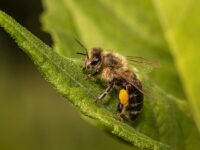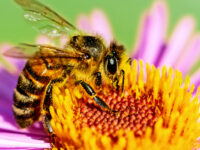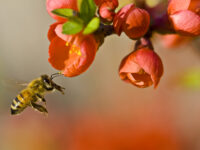Contrary to our peaceful perception of the humble bee, foraging for pollen can be a treacherous journey filled with seduction and trickery. Bees don’t get a “free lunch” in their mutualistic relationship with flowers. Instead, flowers often exploit bees as vessels for pollination, forcing them to endure trials reminiscent of Jason’s endeavors for the Golden Fleece.
Students often learn that flowers attract bees through visual and olfactory stimuli. Flowers develop traits to advertise their nectar in a bid to woo bees in “pollinator Tinder.” From seductive colors and scents to UV spectrum “bullseye nectar guides,” flowers have evolved to be as alluring as possible to any passing bee.
Despite flowers’ extensive efforts to attract pollinators, they are incredibly selective with who receives their nectar — a high-calorie and nutritionally expensive substance to produce. According to a study by State University of New York professor Edward Southwick, nectar production can take up to 37% of a plant’s daily phosphate intake. Thus, flowers seek efficient pollinators who will spread pollen widely and need minimal nectar as an incentive. Like Jason, bees must prove themselves through Olympic challenges before receiving their prize.
When the bees finally arrive at safety and nectar, the flower cunningly plants pollen on the bees’ backsides
Orchids, for instance, are a particularly picky plant. The bucket orchid forces bees through a treacherous obstacle course: dangling upside down, wading through puddles of liquid, and finally, trudging up a narrow spout. When the bees finally arrive at safety and nectar, the flower cunningly plants pollen on the bees’ backsides — primed for pollinating other flowers but useless for feeding fellow bees.
To further manipulate pollinators, species of flowers may resort to false nectar pockets, traps, and even sexual seduction. The cruelest trial comes from the bee orchid and its deceptive mimicry. The journey begins with seducing male bees, using the alluring scent of an amorous and available female. Captivated male bees then pounce on the bee-like flowers and proceed with pseudo-copulation, attempting to inseminate the flower. Tragically, as the bee realizes its mistake, two pollen packets have been carefully placed on his abdomen for delivery to the next flower. American biologist Thor Hanson captures the ingenuity of the bee orchid: “All those male bees ‘attacking’ bee orchids excel at pollination without even realizing they’ve visited a flower.”
However, bees are not powerless victims to be exploited by flowers. Jason overcame King Aeete’s challenges with sheer ingenuity and specialized potions. Similarly, bees have developed all kinds of techniques for circumventing a flower’s carefully constructed pollination scheme. Short-tongued bumble bees, for instance, will chew through the base of flower blossoms to reach nectar, providing other pollinators with easy access as well. Other bees engage in a sort of “bee thievery,” which involves sneaking behind the gaps between petals and has perhaps encouraged the evolution of tightly clustered flowers with protected backs.
To further manipulate pollinators, species of flowers may resort to false nectar pockets, traps, and even sexual seduction.
Even when bees play nice, pollinating flowers is more of an offshoot consequence. Bee interests lie in efficiently gathering pollen for their personal use, with highly evolved species carefully grooming stray pollen from their bodies and packing it into dense clumps on their back legs. The stark truth is this: Bees perceive flowers as a resource, while flowers use bees as convenient tools.
Rather than a simple “win-win,” the relationship between bees and flowers is akin to an arms race of evolution and ingenuity. Coevolution has created many exclusive relationships between species of bees and flowers, evident in the specialization of traits from bee tongue lengths to the depths of flower spurs. According to a team of researchers from the California State University biology department, the specialized relationship between zygomorphic flowers — those that are bilaterally symmetric — and their pollinator species results in overdependence and a heightened risk of extinction for both species.
The beauty of flowers represents generations of evolutionary forces in the natural process of competition, making the spring blooms all the more awe-inspiring and powerful. Every floral color, smell, and structure is artfully crafted with the exploitation of bees in mind. We are simply witnesses to the heroic efforts of bees and the intentional treachery of flowers in this incredible evolutionary odyssey.



